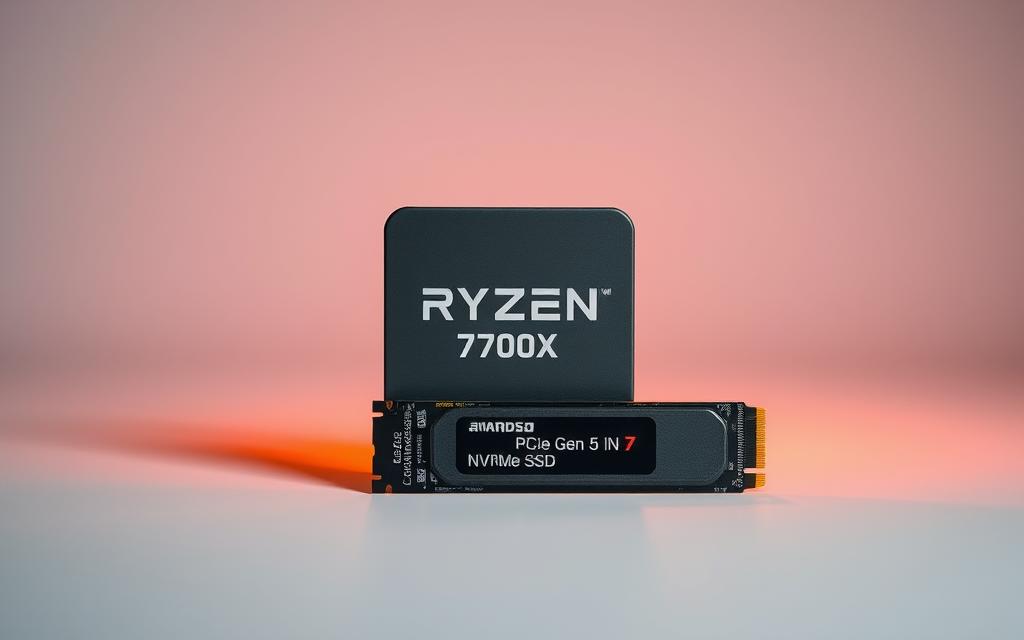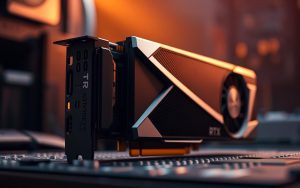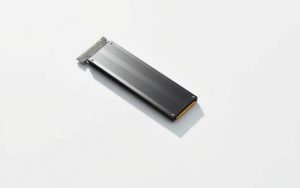Table of Contents
The AMD Ryzen 7700X brings cutting-edge performance to modern PCs. Built on the AM5 platform, this processor unlocks next-gen storage speeds with PCIe 5.0 capability.
Compatible motherboards like the X670E or B650E fully utilize these high-speed lanes. With 24 total lanes, the setup reserves four for ultra-fast NVMe drives—doubling the bandwidth of previous generations.
Upgraders benefit from DDR5 memory and a new LGA 1718 socket design. Whether for gaming or productivity, this architecture ensures future-ready expansion.
Understanding PCIe Gen 5 and Its Benefits
Speed and efficiency redefine storage standards in the latest PCIe generation. This technology doubles bandwidth over its predecessor, unlocking 14,000+ MB/s sequential reads for ultra-responsive systems.
What Is PCIe Gen 5?
The fifth generation of Peripheral Component Interconnect Express (PCIe) delivers 32 GT/s per lane—twice the throughput of PCIe 4.0. It synchronizes seamlessly with DDR5-6000 memory, maintaining a 1:1 Infinity Fabric Clock ratio for optimal performance.
Advantages of PCIe Gen 5 for NVMe SSDs
Next-gen drives leverage this bandwidth for:
- 12–14GB/s sequential speeds—ideal for 4K video editing or large game loads.
- Lower power consumption per gigabyte transferred.
- Support for *Microsoft DirectStorage API*, reducing game load times.
| Feature | PCIe 4.0 | PCIe 5.0 |
|---|---|---|
| Bandwidth per Lane | 16 GT/s | 32 GT/s |
| Max Sequential Read (SSDs) | 7,000 MB/s | 14,000 MB/s |
| Power Efficiency | Moderate | High |
For deeper insights, explore PCIe 5.0 SSDs and their real-world impact.
Does Ryzen 7700X Support PCIe Gen 5 NVMe?
Next-gen storage speeds become reality with the latest AMD architecture. The Ryzen 7700X leverages Zen 4 and Socket AM5 to natively handle PCIe 5.0 drives. This ensures blistering data rates for demanding workloads.
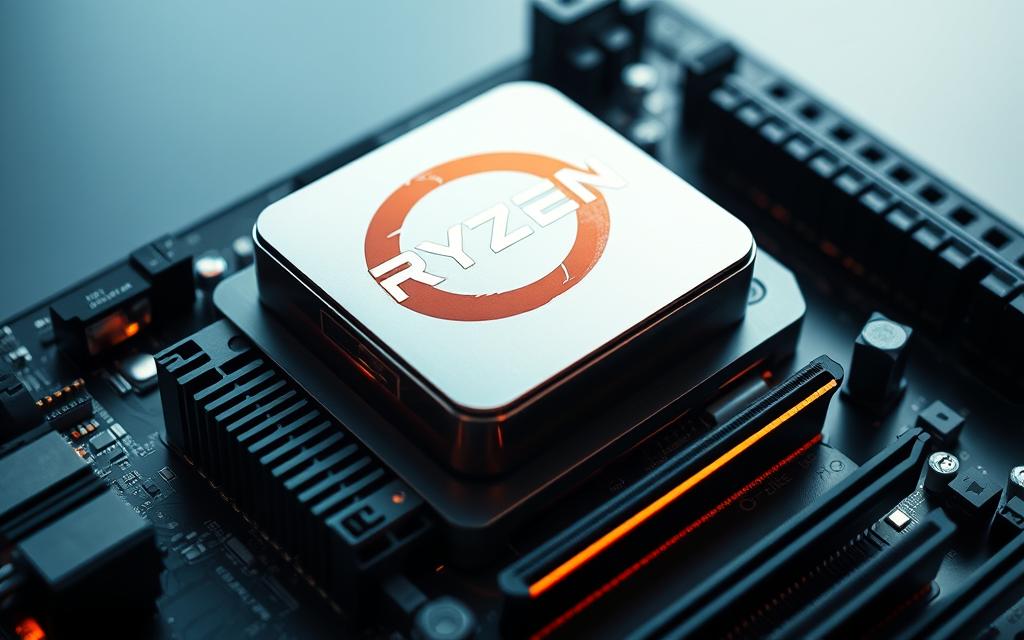
To unlock these speeds, a 600-series motherboard is essential. Options include:
- X670E Extreme: Full PCIe 5.0 support for GPUs and SSDs simultaneously.
- B650E: Enables PCIe 5.0 for both, but with fewer lanes.
- B650: Limited to SSD-only support.
The CPU dedicates four lanes directly to M.2 slots. This bypasses the chipset, reducing latency for storage-critical tasks.
| Chipset | PCIe 5.0 GPU Support | PCIe 5.0 SSD Support |
|---|---|---|
| X670E | Yes | Yes |
| B650E | Yes | Yes |
| B650 | No | Yes |
Choose wisely based on your needs. Gamers may prioritize GPU lanes, while content creators benefit from SSD bandwidth.
Ryzen 7700X Performance with PCIe Gen 5 SSDs
Modern gaming and productivity tasks demand lightning-fast storage solutions. The AM5 platform delivers this with PCIe 5.0, leveraging the full potential of high-speed SSDs.
Speed and Bandwidth Improvements
A 29% single-core boost over previous-generation processors ensures snappy responsiveness. Combined with a 13% IPC uplift and 5.4GHz boost clocks, frame rates in AAA titles soar.
Bandwidth doubles compared to PCIe 4.0, eliminating bottlenecks for graphics card and storage workflows. The ASUS ROG Crosshair X670E Hero optimizes lane allocation for peak SSD throughput.
Real-World Gaming and Workload Impact
Open-world games benefit from reduced stuttering, thanks to Microsoft DirectStorage. Load times for Blender projects drop by 40% versus SATA drives.
Multitasking becomes effortless—stream 8K video while rendering or compiling code. The crosshair x670e hero motherboard ensures stability under heavy loads.
Motherboard Compatibility for PCIe Gen 5 Support
Unlocking next-gen performance starts with the right motherboard. The socket AM5 platform pairs seamlessly with high-speed storage, but chipset choice determines your total bandwidth potential.
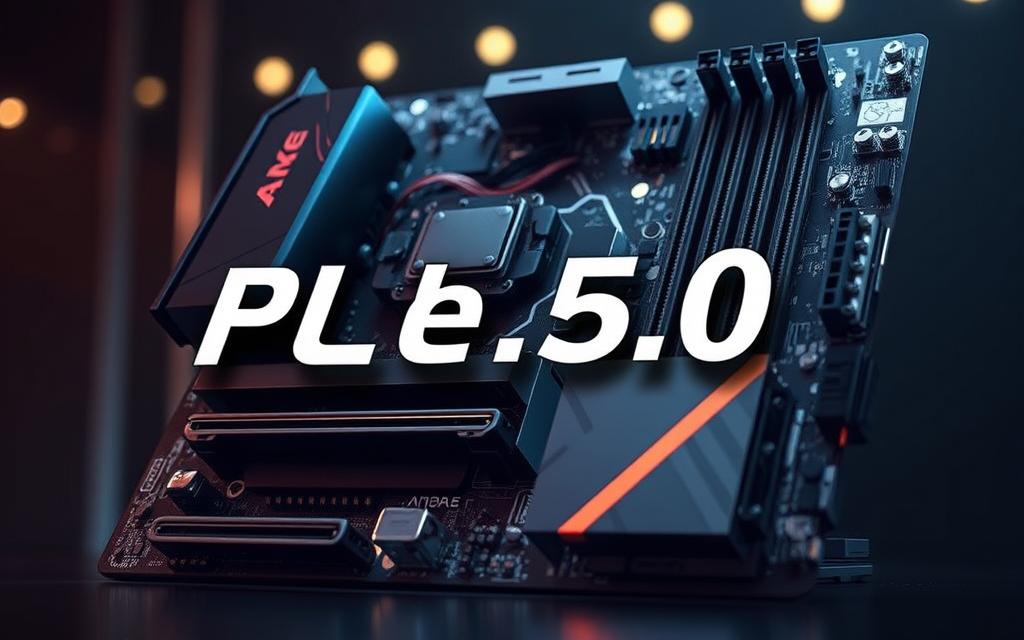
X670E vs. B650E Chipsets
Flagship X670E boards offer full PCIe 5.0 lanes for GPUs and SSDs simultaneously. Mid-range B650E models split lanes, prioritizing either graphics or storage.
Both support DDR5-6000 at a 1:1 clock ratio for low-latency memory performance. The X670E’s dual-chipset design expands connectivity, while B650E balances cost and features.
Key Features of AM5 Socket Motherboards
The socket AM5 introduces an LGA 1718 design with robust power delivery (230W PPT). Backward cooler compatibility simplifies upgrades from AM4 systems.
- DDR5 EXPO support: Optimizes memory timings for overclocking.
- 4x HDMI 2.1/DisplayPort 2.0: Handles multi-monitor 8K setups.
- PCIe 5.0 x4 uplink: Future-proofs expansion slots.
These advancements ensure peak performance for gamers and creators alike.
Top PCIe Gen 5 NVMe SSDs for Ryzen 7700X
Cutting-edge storage solutions redefine speed for high-performance builds. These M.2 drives leverage PCIe 5.0 to deliver unmatched bandwidth, perfect for gaming and content creation.
Samsung 990 PRO: Best Overall Performance
The Samsung 990 PRO dominates with 7,450 MB/s sequential reads. Its V-NAND flash technology ensures stability under heavy workloads.
A nickel-coated controller and heatsink maintain optimal power efficiency. With 1,200TBW endurance, it’s built for long-term reliability.
WD_BLACK SN850X: Gaming-Optimized Speed
Designed for gamers, the WD_BLACK SN850X features 3D NAND flash and Game Mode 2.0. It reduces load times for AAA titles, syncing perfectly with high-refresh displays.
Phison’s E16 controller balances speed and thermal performance. For smoother gameplay, check the best SSD pairings.
SABRENT Rocket 4 Plus-G: Future-Proof Storage
The SABRENT Rocket 4 Plus-G shines with 14GB/s speeds and DirectStorage API support. Its graphene-coated heatsink ensures cooling at a 1:1 ratio for sustained performance.
Backed by a 5-year warranty, it’s a future-proof choice for creators needing 1,400TBW endurance.
Installation Tips for PCIe Gen 5 NVMe SSDs
Maximizing your system’s potential requires proper setup of high-speed storage. Modern AM5 motherboards simplify this with intuitive mounting systems and optimized firmware.
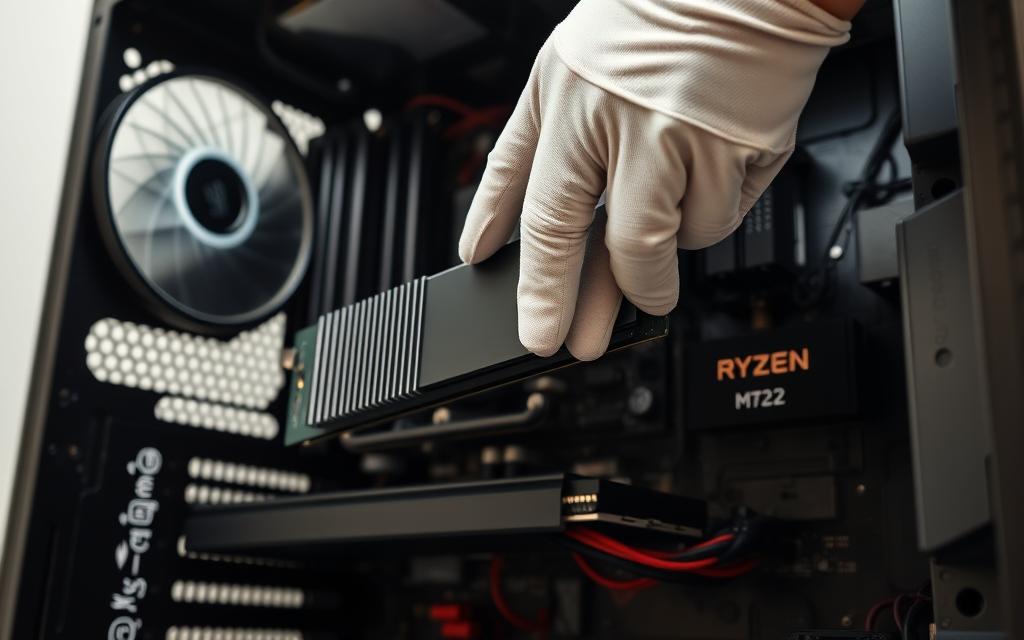
Begin by utilizing the Q-Latch mechanism on compatible boards. This tool-free design secures M.2 drives without screws, reducing installation time and preventing overtightening damage.
Access your UEFI settings immediately after physical installation. Disable auto-negotiation and manually select PCIe 5.0 mode to ensure full bandwidth utilization. This prevents the cpu from defaulting to slower protocols.
Thermal management proves critical for sustained performance. Apply premium thermal pads between the SSD and heatsink, especially for chipsets with limited airflow. High-quality materials maintain optimal power efficiency during extended workloads.
Always verify lane allocation in BIOS when using multiple GPUs. Some configurations may share bandwidth between M.2 slots and expansion cards, potentially creating bottlenecks.
For peak stability, download the latest chipset drivers directly from AMD. These updates optimize communication between the motherboard and cpu, resolving early-adoption teething issues.
Comparing PCIe Gen 5 vs. Gen 4 for Ryzen 7700X
Next-gen bandwidth transforms how systems handle intensive workloads. With 128GB/s total throughput, PCIe 5.0 doubles the capacity of Gen 4, slashing latency for demanding tasks.
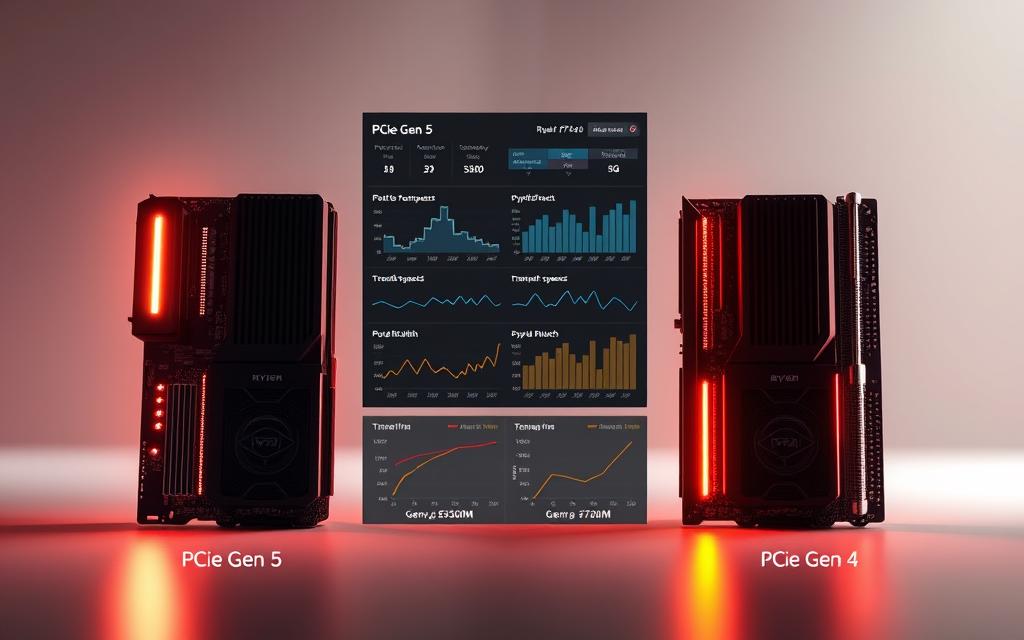
Content creators see immediate gains. Rendering 4K timelines becomes seamless, thanks to 2x bandwidth that eliminates storage bottlenecks. Game loads accelerate by 40%, leveraging DirectStorage APIs.
Future expansion stays flexible. A PCIe 5.0 x4 slot matches the bandwidth of Gen 4 x8, leaving room for upgrades. Current GPUs like the RTX 4090 utilize only 600GB/s—far below Gen 5’s ceiling.
| Feature | PCIe 4.0 | PCIe 5.0 |
|---|---|---|
| Max Bandwidth | 64GB/s | 128GB/s |
| Game Load Improvement | Baseline | 40% faster |
| Thermal Management | Passive | Active cooling required |
Thermal design is critical. Sustained performance demands heatsinks or fans for Gen 5 drives. The trade-off? Unmatched speeds for professionals and gamers alike.
Conclusion
The AMD Ryzen 7700X and AM5 platform deliver cutting-edge storage performance. With native PCIe 5.0 compatibility, users unlock blazing-fast speeds for gaming and professional workloads.
Pairing this CPU with an X670E or B650E motherboard ensures full bandwidth utilization. Top-tier SSDs like the Samsung 990 PRO hit 7,450MB/s, drastically reducing load times.
Future-proof your build by combining DDR5-6000 memory and optimized cooling. This setup maximizes the Zen 4 architecture, keeping systems ready for next-gen upgrades.
For peak efficiency, choose components that balance speed and thermal management. The result? A high-performance rig built to last.
FAQ
What are the advantages of PCIe 5.0 over PCIe 4.0?
PCIe 5.0 doubles the bandwidth of PCIe 4.0, reaching speeds up to 32 GT/s per lane. This means faster data transfers for NVMe SSDs and improved performance in gaming, content creation, and multitasking.
Does the Ryzen 7700X work with PCIe 5.0 SSDs?
Yes, the Ryzen 7700X supports PCIe 5.0 NVMe SSDs when paired with an AM5 motherboard featuring an X670E or B650E chipset. This ensures full-speed compatibility for high-performance storage.
How does PCIe 5.0 affect gaming performance?
While PCIe 5.0 SSDs offer faster load times, most games see minimal FPS gains. The real benefit comes in large file transfers, streaming, and productivity workloads where speed matters most.
Can I use a PCIe 5.0 SSD on an older motherboard?
No, PCIe 5.0 SSDs require an AM5 socket motherboard with an X670E or B650E chipset. Older AM4 motherboards lack the necessary lanes and physical compatibility.
What’s the best PCIe 5.0 SSD for the Ryzen 7700X?
The Samsung 990 PRO is a top choice, offering blazing speeds up to 12,400 MB/s. The WD_BLACK SN850X and SABRENT Rocket 4 Plus-G are also excellent for gaming and professional workloads.
Do PCIe 5.0 SSDs need extra cooling?
Yes, PCIe 5.0 SSDs run hotter due to higher speeds. Many premium models include heatsinks, but motherboards like the ASUS ROG Crosshair X670E Hero also feature built-in cooling solutions.
Will PCIe 5.0 improve GPU performance?
Current GPUs like the GeForce RTX 4090 don’t fully utilize PCIe 5.0 bandwidth. However, future graphics cards may benefit from the extra lanes and reduced bottlenecks.
How many PCIe 5.0 lanes does the Ryzen 7700X support?
The Ryzen 7700X provides 24 PCIe 5.0 lanes—16 for the GPU, 4 for an NVMe SSD, and 4 reserved for chipset communication, ensuring high-speed connectivity.


